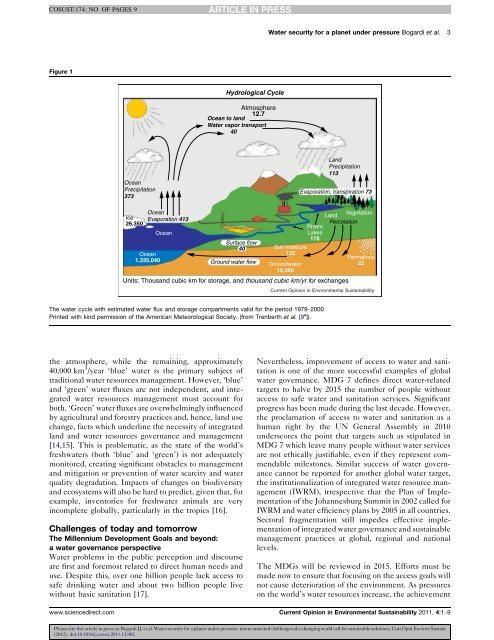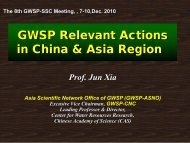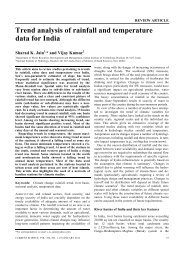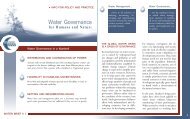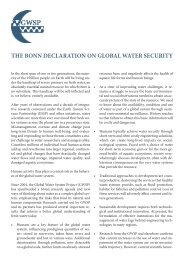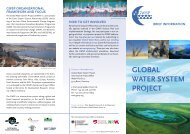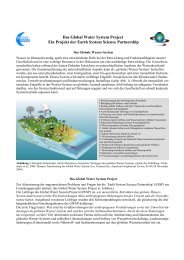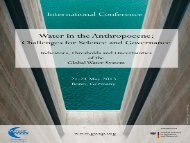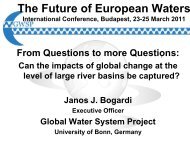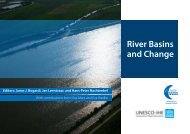Water security for a planet under pressure: interconnected ... - GWSP
Water security for a planet under pressure: interconnected ... - GWSP
Water security for a planet under pressure: interconnected ... - GWSP
Create successful ePaper yourself
Turn your PDF publications into a flip-book with our unique Google optimized e-Paper software.
COSUST-174; NO. OF PAGES 9<br />
<strong>Water</strong> <strong>security</strong> <strong>for</strong> a <strong>planet</strong> <strong>under</strong> <strong>pressure</strong> Bogardi et al. 3<br />
Figure 1<br />
Hydrological Cycle<br />
Atmosphere<br />
12.7<br />
Ocean to land<br />
<strong>Water</strong> vapor transport<br />
40<br />
Ocean<br />
Precipitation<br />
373<br />
Land<br />
Precipitation<br />
113<br />
Evaporation, transpiration 73<br />
Ice<br />
26,350<br />
Ocean<br />
Evaporation 413<br />
Ocean<br />
1,335,040<br />
Ocean<br />
Surface flow<br />
40<br />
Ground water flow<br />
Soil moisture<br />
122<br />
Groundwater<br />
15,300<br />
Land<br />
Vegetation<br />
Percolation<br />
Rivers<br />
Lakes<br />
178<br />
Units: Thousand cubic km <strong>for</strong> storage, and thousand cubic km/yr <strong>for</strong> exchanges<br />
Permafrost<br />
22<br />
Current Opinion in Environmental Sustainability<br />
The water cycle with estimated water flux and storage compartments valid <strong>for</strong> the period 1979–2000<br />
Printed with kind permission of the American Meteorological Society. (from Trenberth et al. [9 ]).<br />
the atmosphere, while the remaining, approximately<br />
40,000 km 3 /year ‘blue’ water is the primary subject of<br />
traditional water resources management. However, ‘blue’<br />
and ‘green’ water fluxes are not independent, and integrated<br />
water resources management must account <strong>for</strong><br />
both. ‘Green’ water fluxes are overwhelmingly influenced<br />
by agricultural and <strong>for</strong>estry practices and, hence, land use<br />
change, facts which <strong>under</strong>line the necessity of integrated<br />
land and water resources governance and management<br />
[14,15]. This is problematic, as the state of the world’s<br />
freshwaters (both ‘blue’ and ‘green’) is not adequately<br />
monitored, creating significant obstacles to management<br />
and mitigation or prevention of water scarcity and water<br />
quality degradation. Impacts of changes on biodiversity<br />
and ecosystems will also be hard to predict, given that, <strong>for</strong><br />
example, inventories <strong>for</strong> freshwater animals are very<br />
incomplete globally, particularly in the tropics [16].<br />
Challenges of today and tomorrow<br />
The Millennium Development Goals and beyond:<br />
a water governance perspective<br />
<strong>Water</strong> problems in the public perception and discourse<br />
are first and <strong>for</strong>emost related to direct human needs and<br />
use. Despite this, over one billion people lack access to<br />
safe drinking water and about two billion people live<br />
without basic sanitation [17].<br />
Nevertheless, improvement of access to water and sanitation<br />
is one of the more successful examples of global<br />
water governance. MDG 7 defines direct water-related<br />
targets to halve by 2015 the number of people without<br />
access to safe water and sanitation services. Significant<br />
progress has been made during the last decade. However,<br />
the proclamation of access to water and sanitation as a<br />
human right by the UN General Assembly in 2010<br />
<strong>under</strong>scores the point that targets such as stipulated in<br />
MDG 7 which leave many people without water services<br />
are not ethically justifiable, even if they represent commendable<br />
milestones. Similar success of water governance<br />
cannot be reported <strong>for</strong> another global water target,<br />
the institutionalization of integrated water resource management<br />
(IWRM), irrespective that the Plan of Implementation<br />
of the Johannesburg Summit in 2002 called <strong>for</strong><br />
IWRM and water efficiency plans by 2005 in all countries.<br />
Sectoral fragmentation still impedes effective implementation<br />
of integrated water governance and sustainable<br />
management practices at global, regional and national<br />
levels.<br />
The MDGs will be reviewed in 2015. Ef<strong>for</strong>ts must be<br />
made now to ensure that focusing on the access goals will<br />
not cause deterioration of the environment. As <strong>pressure</strong>s<br />
on the world’s water resources increase, the achievement<br />
www.sciencedirect.com Current Opinion in Environmental Sustainability 2011, 4:1–9<br />
Please cite this article in press as: Bogardi JJ, et al. <strong>Water</strong> <strong>security</strong> <strong>for</strong> a <strong>planet</strong> <strong>under</strong> <strong>pressure</strong>: <strong>interconnected</strong> challenges of a changing world call <strong>for</strong> sustainable solutions, Curr Opin Environ Sustain<br />
(2012), doi:10.1016/j.cosust.2011.12.002


